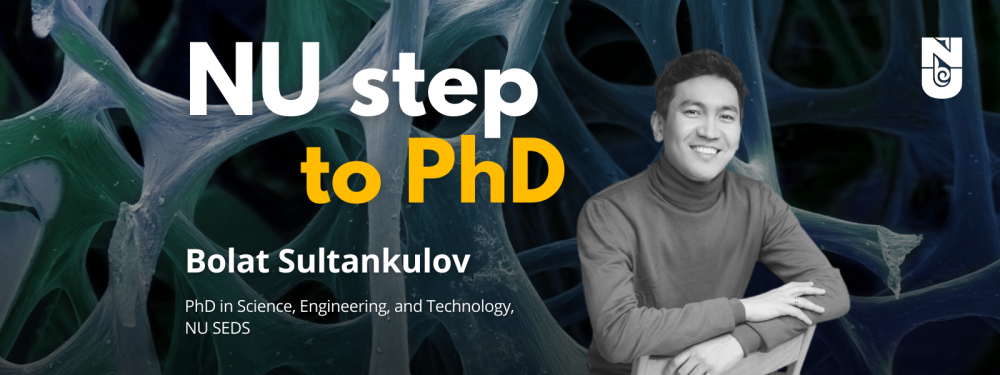NU Step to PhD: Bolat Sultankulov, PhD graduate in Science, Engineering and Technology
Our next NU Step to PhD guest is Bolat Sultankulov, a PhD graduate in Science, Engineering, and Technology at NU SEDS. Prior to embarking on his research career, he studied genetics at Nottingham University on a “Bolashak” Scholarship. He established a startup in the field of diagnostics using an alternative method of polymerase chain reaction in a collaboration with his colleagues in 2014. Additionally, he is a co-founder of the “Pomme de Vie” company, which developed a serum for skin regeneration based on growth factors secreted by stem cells, a co-founder of Kletochnaya terapiya LLP which is focused on the development of therapies based on autologous somatic cells and already providing service to several clinics in Nur-Sultan, Almaty and Shymkent since 2014. In 2017, he received the “Leader of Science – 2017” award for his and his colleagues merits in science. He is also a co-founder of Arlan Biotech LLP which is working on the development of rapid antigen tests against coronavirus (SYNTHETIQ) and other infectious agents.
Tell us about your doctoral research?
For my doctoral study, I was engaged in regenerative biology research, namely the creation of a biomaterial for bone tissue regeneration based on various polymers. In our research, we employed an already well-known technique for obtaining the so-called “cryogel” acquired by chemical cross-linking at low temperatures.
Cryogels are porous materials, and this porosity increases their surface area, which allows them to attach more biologically active molecules to the material, for example, stem cells. We tried to create a cryogel on which various proteins can be applied that can support not only the viability of stem cells but also stimulate their transformation into bone tissue cells.
In our work, we have developed a method for obtaining an “inexpensive” cryogel capable of naturally binding to proteins and growth factors, as well as other biologically active molecules.
We also studied the possibility of obtaining a so-called polyelectrolyte cryogel. In our work we used chitosan, heparin, and polyvinyl alcohol. We wanted to use heparin and chitosan in our cryogel. Many proteins bind to heparin, and chitosan is a sufficiently studied polymer which shows acceptable biocompatibility. However, when chitosan and heparin are mixed, a so-called polyelectrolyte complex is instantly formed, which makes it impossible to create a cryogel. Through my experiments, I stumbled upon the discovery that when polyvinyl alcohol is added to chitosan and heparin, a polyelectrolyte complex does not instantly form. This makes possible to add crosslinking agents to produce cryogel before the polyelectrolye complex forms. The resulting cryogel binds to heparin-binding proteins and supports the differentiation of stem cells.
What is the applied value of your work?
It will be possible to use the developed cryogel to create biomaterials for bone regeneration. Before that, the cyrogel needs to be clinically tested. Another application of my work is its usage for skin lesion regeneration. My supervisor, Arman Saparov, collaborated with Japanese scientists from Fukuoka University, and we had shipped them our biomaterial, which they tested to regenerate mice’s skin. It has been shown that our material is suitable for these purposes and is quite effective. All the obtained results have been published in Q1 ranked journals.
What can you tell us about the process of writing your thesis?
My research involved both experimental and theoretical work. I was engaged in experimental work because the original goal was to create a cryogel-based biomaterial with certain properties. I did not have a clear plan, but only a general vision and certain knowledge. The experimental work itself is very interesting as it allows us to test different variations of protocols, compounds, reagents, and strategies on an ongoing basis. By conducting such work, we can expect an outcome, though this outcome is not always what we had expected.
There can be surprises in science as well. For example, the necessity of adding polyvinyl alcohol was determined by accident. I was sitting in a laboratory at the University of Brighton (UK) in a sad mood because I could not get the material that I had wanted to obtain.
I was thinking that it would probably be better to change my research topic, because at that moment I was at a dead end. In this mood, I started mixing polymers with each other. I added polyvinyl alcohol simply because it was on my table. I was so surprised to discover that it may have been the missing link in obtaining the cryogel.
But the most important thing during doctoral study was mutual assistance. PhD students shared reagents with me and helped me to work with the equipment. Science is a collaborative process. Help from researchers and collaboration with other students allowed me to reach positive results in my study.
Please, tell us about your future plans?
At the moment, I am more engaged in commercial developments. It is most likely that in the future I will also be engaged in commercial science and entrepreneurship. I really enjoy it. I also conduct research, a huge amount of experimental work, but I like to do it with the ultimate goal of a product that can be commercialized and set in production. I am planning to continue my studies further and studybusiness in the near future.
What would you advise to future doctoral students?
I wish them patience, hard work, and success!


